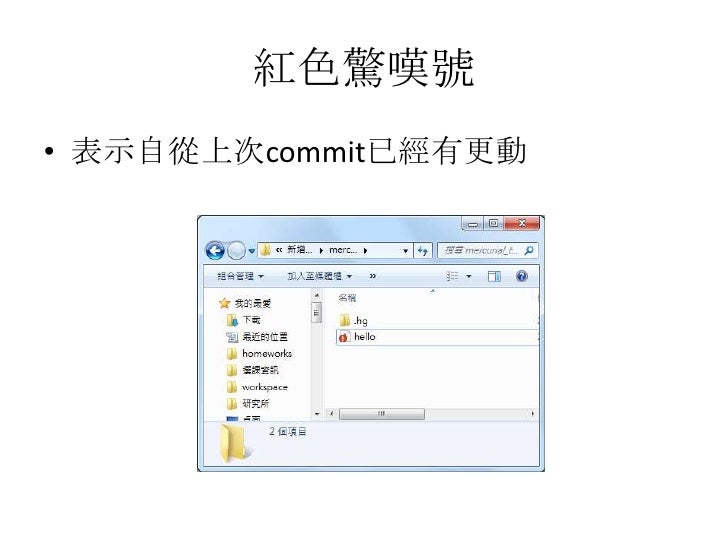
- Mercurial tortoisehg tutorial update#
- Mercurial tortoisehg tutorial code#
- Mercurial tortoisehg tutorial series#
It will give you an option to revert changes not already committed.
Mercurial tortoisehg tutorial update#
If you want to undo a Merge that is not already committed (because you cancelled it) you can Update to the last revision. Removing a changeset also removes all of its children, so it can only be used to truncate history, not remove a slice. Net effect is an undo, but the change remains in your history. Will undo the last pull or commit (can be dangerous)Ĭreate a new commit that is the inverse of a given commit. Once all conflicts are addressed, the graft process can be continued with the -c/-continue option. If a graft merge results in conflicts, the graft process is interrupted so that the current merge can be manually resolved. By default, graft will copy user, date, and description from the source changesets.Ĭhangesets that are ancestors of the current revision, that have already been grafted, or that are merges will be skipped. This is sometimes known as 'backporting' or 'cherry-picking'. This command uses Mercurial's merge logic to copy individual changes from other branches without merging branches in the history graph. Ref: Mercurial Kick Start tutorial, The Definitive Guide.Copy changes from other branches onto the current branch

But If you want to quickly share your local repository inside local network with out pushing to central server then either copy the whole folder or run the TortoiseHg webserver Right click and "Update" for the working directory to update. Once the changes are pulled, the local repository contains all the change sets, but it doesnt update the working folder yet. Click on the "Pull incoming change sets". When it asks for credentials, give your bitbucket credentials.Īs part of your collaborative work, you may want to pull the changes made by others to your local repository. Make sure your central repository url is right. You can push the changes to central repository. This is your own repository, committing to this doesn't change the central (bitbuket) repository. This commits the changes to local repository. You can add files or commit changes to local repository by right clicking on the folder and clicking commit. (.hg contains all the historical changes) This is a complete working repository with all the historical data. This creates a local copy of the repository. Or right click inside your file browser - TortoiseHg - Clone You can do it using the command prompt >hg clone Now to work on the source files you need to clone the repository to local machine. It also includes a Gnome/Nautilus extension and a CLI wrapper application so the TortoiseHg tools can be used on non-Windows platforms.
Mercurial tortoisehg tutorial series#
TortoiseHg is a Windows shell extension and a series of applications for the Mercurial distributed revision control system. Make sure you have write access so you can push the changes.Ģ. Esto puede parecer que ocuparía mucho espacio en el disco, pero en la mayoría de los sistemas operativos, mercurial creará enlaces físicos en lugar de copiar los archivos. Luego, puede fusionar los repositorios separados una vez que haya realizado sus ediciones y confirmaciones. Optionally restrict it to just running hg (mercurial) command'hg -R pathto/repo serve -stdio' ssh-rsa AAAA1. So here is an amalgam of the release notes.

I looked around for a complete end to end tutorial without success.

TortoiseHg binary packages list Mercurial as a dependency, so it is usually installed for you automatically. La mayor parte del tiempo en mercurial, clone el repositorio para hacer una rama. So here are the steps I followed to get this working. You must have Mercurial installed separately in order to run TortoiseHg on Linux. You can also contact the admin of existing repository and join as contributer. TortoiseHg consists of a command line thg script and a Nautilus extension which provides overlays and context menus in your file explorer. By forking you will create a new repository which is an exact copy of the original repository with you as admin.

Either create a new project repository or fork/join existing repository. There are two ways to start with bitbucket. This tutorial is my regular workflow involving Mercurial and BitBucket. You know the reason why I chose Bitbucket/Hg as opposed to GitGub/git.
Mercurial tortoisehg tutorial code#
Bitbucket is a free code hosting site for the popular Mercurial distributed version control system. It efficiently handles projects of any size and offers an easy and intuitive. Mercurial is a free, distributed source control management tool.


 0 kommentar(er)
0 kommentar(er)
